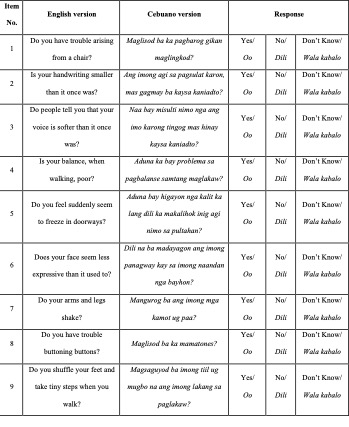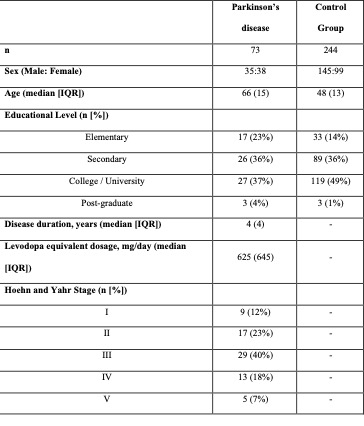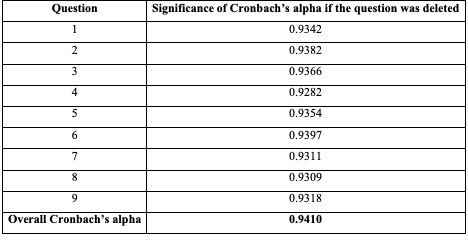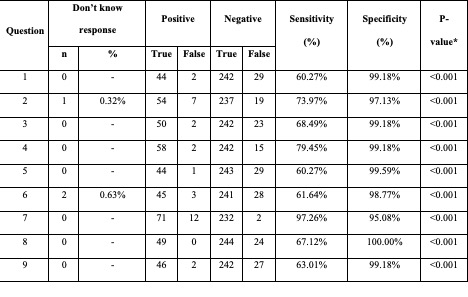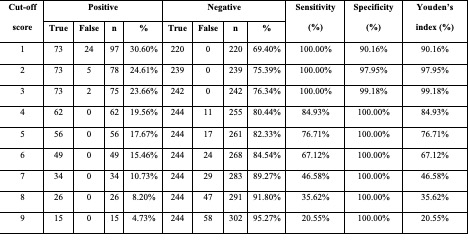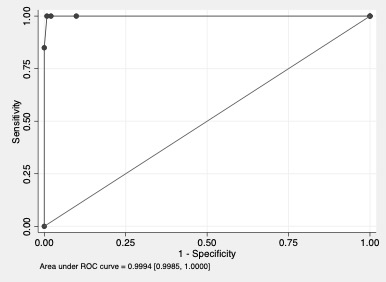Category: Epidemiology
Objective: To determine the validity of the Cebuano version of a PD screening questionnaire
Background: In the Philippines, actual prevalence of Parkinson’s Disease (PD) is not yet determined. Although cases can be extrapolated from medical registries, this method may undermine actual case rates. Community cases are missed for lack of data collection instruments. Therefore, a reliable screening tool for PD is essential in the timely diagnosis and epidemiological studies. The most widely used screening questionnaire for PD diagnosis was developed by Tanner et al. Although this questionnaire has been translated to several languages, translated version must be validated for use in our local setting.
Method: To achieve a power of 80%, 75 PD patients and 244 controls were enrolled [table2]. The questionnaire consisted of nine questions about the motor symptoms of PD. The questionnaire was translated from English to Cebuano by a hired language specialist. It was subsequently administered to both PD and controls. Each item was supplied with a “yes”, “no” or “don’t know” answer [table1].
Results: The overall Cronbach’s alpha for internal consistency of the questionnaire was 0.9410 [table3]. The item on “tremor” had the highest sensitivity (97.26%), while the item on “problems with buttoning” had the highest specificity (100.00%) [table4]. A cut-off score of >3 obtained the best Youden’s index (99.18%) with a sensitivity of 100.00% and a specificity of 99.18% [table5]. The questionnaire had an almost perfect predicting ability to diagnose PD (AUC of 0.9994) [figure1].
Conclusion: The translated version of the Tanner questionnaire is a validated instrument to identify PD in a literate Cebuano population.
References: 1. Postuma RB, Berg D, Stern M, Poewe W, Olanow CW, Oertel W, et al. MDS clinical diagnostic criteria for Parkinson’s disease. Mov Disord [Internet]. 2015 Oct;30(12):1591–601. Available from: https://onlinelibrary.wiley.com/doi/10.1002/mds.26424
2. Zhao N, Yang Y, Zhang L, Zhang Q, Balbuena L, Ungvari GS, et al. Quality of life in Parkinson’s disease: A systematic review and meta‐analysis of comparative studies. CNS Neurosci Ther [Internet]. 2021 Mar 28;27(3):270–9. Available from: https://onlinelibrary.wiley.com/doi/10.1111/cns.13549
3. Dahodwala N, Siderowf A, Baumgarten M, Abrams A, Karlawish J. Screening questionnaires for parkinsonism: A systematic review. Parkinsonism Relat Disord [Internet]. 2012 Mar;18(3):216–24. Available from: https://linkinghub.elsevier.com/retrieve/pii/S1353802011003002
4. C. Tanner, D. Gilley CG. A brief screening questionnaire for Parkinsonism. Ann Neurol. 1990;18:267–8.
5. Hughes AJ, Daniel SE, Kilford L, Lees AJ. Accuracy of clinical diagnosis of idiopathic Parkinson’s disease: a clinico-pathological study of 100 cases. J Neurol Neurosurg Psychiatry [Internet]. 1992 Mar 1;55(3):181–4. Available from: https://jnnp.bmj.com/lookup/doi/10.1136/jnnp.55.3.181
6. Tomlinson CL, Stowe R, Patel S, Rick C, Gray R, Clarke CE. Systematic review of levodopa dose equivalency reporting in Parkinson’s disease. Mov Disord [Internet]. 2010 Nov 15;25(15):2649–53. Available from: https://onlinelibrary.wiley.com/doi/10.1002/mds.23429
7. Goetz CG, Tilley BC, Shaftman SR, Stebbins GT, Fahn S, Martinez-Martin P, et al. Movement Disorder Society-sponsored revision of the Unified Parkinson’s Disease Rating Scale (MDS-UPDRS): Scale presentation and clinimetric testing results. Mov Disord [Internet]. 2008 Nov 15;23(15):2129–70. Available from: https://onlinelibrary.wiley.com/doi/10.1002/mds.22340
8. Wei Z, Xiaoyuan N, Shengwei G, Zhizong H, Jiyuan L, Yang L. Evaluation of a screening questionnaire for Parkinson’s disease in a Chinese population. J Clin Neurosci [Internet]. 2014 Feb;21(2):278–81. Available from: https://linkinghub.elsevier.com/retrieve/pii/S0967586813002774
9. Shalash A, Okubadejo NU, Doumbe J, Ojo OO, Hamid E, Kuate C, et al. Translation, Validation, Diagnostic Accuracy, and Reliability of Screening Questionnaire for Parkinsonism in Three African Countries. J Parkinsons Dis [Internet]. 2020 Jul 28;10(3):1113–22. Available from: https://www.medra.org/servlet/aliasResolver?alias=iospress&doi=10.3233/JPD-202040
10. Soares C, Carneiro DR, Dias R, Ferreira D, Sousa M, Oliveira A, et al. Behind the Mask: Recognizing Facial Features of Parkinson’s Disease During the
11. Domingo A, Lee L V., Brüggemann N, Freimann K, Kaiser FJ, Jamora RDG, et al. Woman With X-Linked Recessive Dystonia-Parkinsonism. JAMA Neurol [Internet]. 2014 Sep 1;71(9):1177. Available from: http://archneur.jamanetwork.com/article.aspx?doi=10.1001/jamaneurol.2014.56
12. Miller IN, Cronin-Golomb A. Gender differences in Parkinson’s disease: Clinical characteristics and cognition. Mov Disord [Internet]. 2010 Dec 15;25(16):2695–703. Available from: https://onlinelibrary.wiley.com/doi/10.1002/mds.23388
To cite this abstract in AMA style:
D. Dakay, F. Tangcalagan, E. Villanueva Iii, J. Abejero, G. Saranza. Cross-cultural validation of the Cebuano version of a screening questionnaire for Parkinson’s Disease [abstract]. Mov Disord. 2022; 37 (suppl 2). https://www.mdsabstracts.org/abstract/cross-cultural-validation-of-the-cebuano-version-of-a-screening-questionnaire-for-parkinsons-disease/. Accessed April 2, 2025.« Back to 2022 International Congress
MDS Abstracts - https://www.mdsabstracts.org/abstract/cross-cultural-validation-of-the-cebuano-version-of-a-screening-questionnaire-for-parkinsons-disease/

